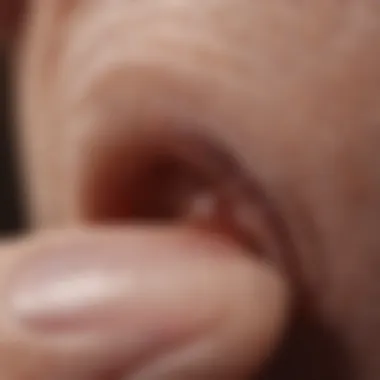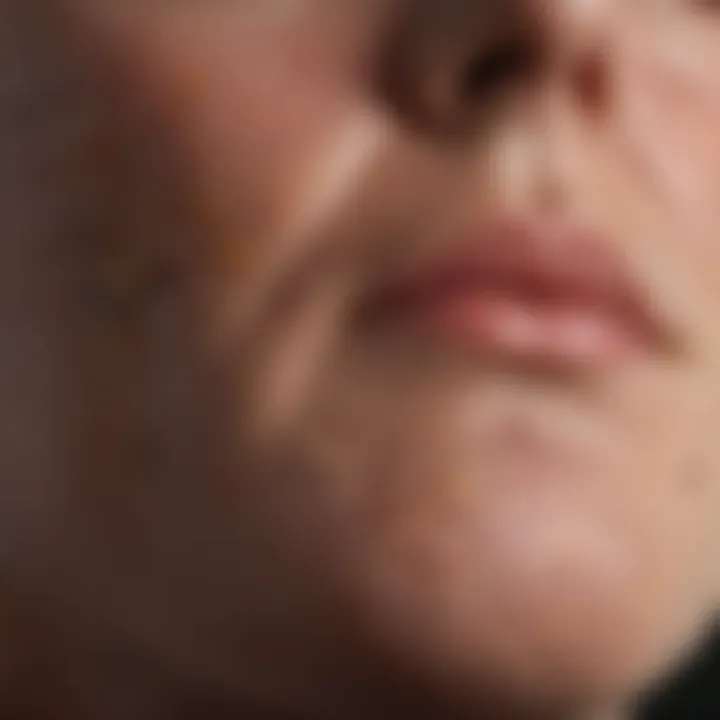Exploring the Causes of Acral Lentiginous Melanoma


Intro
Acral lentiginous melanoma is not something you hear about at every dinner table. Unlike more common types of skin cancer that show up on the face or arms, this particular form tends to appear in less visible spots, namely the palms, soles, and underneath the nails. This presents not only a challenge in detection but also a real difficulty in understanding what paves the way for its development.
Skin cancer, in general, is a subject often shrouded in myths and misconceptions. Many people think that only those with fair skin need to worry about melanoma, while the truth is that acral lentiginous melanoma can affect diverse groups and skin types. Unfortunately, because it can go unnoticed for long periods, it often presents at an advanced stage, which complicates treatment outcomes.
To get ahead of the curve, it’s crucial to delve into the intricate factors behind this seldom-discussed condition. With this article, we aim to illuminate potential causes ranging from genetic predispositions to environmental triggers.
Research Overview
Research into acral lentiginous melanoma isn’t as prolific as in other skin cancer areas. Scientists and medical professionals are beginning to pay more attention as awareness grows. Gathering insights from epidemiological studies allows us to peel back the layers of complexity surrounding this unusual form of melanoma.
Methodological Approaches
Investigating acral lentiginous melanoma often employs a combination of qualitative and quantitative research. Case studies, interviews with patients, and analysis of demographic information provide a rich context. Additionally, genetic analyses and environmental assessments contribute to a more comprehensive understanding.
Various methodologies in this respect might include:
- Genomic sequencing to identify specific mutations linked to melanoma.
- Longitudinal studies to track incidence rates across various populations.
- Comparative analyses between regions with differing sun exposure levels.
Significance and Implications
A centralized focus on this uncommon melanoma type can ultimately steer resources toward earlier intervention and potentially save lives.
Current Trends in Science
The tide is slowly turning as innovative techniques emerge in the study of acral lentiginous melanoma. As technology advances, researchers can delve deeper into the intricacies of this skin condition.
Innovative Techniques and Tools
Recent advancements in radiology, imaging technologies, and histopathology have improved diagnostic accuracy. Noninvasive imaging, for instance, aids healthcare professionals in identifying early lesions that might otherwise go unnoticed. Moreover, artificial intelligence is taking the lead in analyzing dermatological images, helping to flag suspicious spots before they escalate.
Interdisciplinary Connections
Many fields come together in the fight against acral lentiginous melanoma. Geneticists, dermatologists, and public health experts are uniting forces, merging their expertise. This collaborative approach fosters a well-rounded view of the problem, enhancing not just research but patient care.
In summary, the investigation into acral lentiginous melanoma is a multi-faceted endeavor. By understanding its causes, we move closer toward effective solutions and improve ongoing dialogue in oncology.
Foreword to Acral Lentiginous Melanoma
Acral lentiginous melanoma (ALM) often flies under the radar compared to other types of skin cancer. In the grand tapestry of skin malignancies, it holds a unique position, especially due to its distinct presentation on the body. While many people are familiar with melanoma appearing on sun-exposed areas like the face and arms, ALM primarily affects the palms of the hands, soles of the feet, and under the nails. Because of its atypical locations, it can be challenging to recognize in the early stages, making awareness and understanding critical.
Understanding ALM opens the door to not just identification but also prevention strategies that might save lives. A good grasp of this condition can empower healthcare providers and the general public to foster a climate of proactive health management. By highlighting important aspects of ALM, this article aims to weave together the threads of genetics, environmental factors, and socio-demographic elements that play into it. The value of this understanding can't be overstated; it shapes how we approach skin health in today's world.
Definition and Significance
Acral lentiginous melanoma is defined as a type of skin cancer that presents as a brown or black patch on areas where pigmentation is usually not prominent. Unlike superficial spreading melanoma, which is more commonly found among Caucasians, ALM occurs equally across different races and ethnicities. This makes it particularly significant in understanding skin cancer trends since anyone, regardless of skin tone, can be affected.
Its presence on non-exposed areas of the body highlights the need for medical professionals to maintain a broad perspective during skin examinations. Given that early detection typically leads to better outcomes, understanding the defining characteristics of ALM—its size, color changes, and texture aberrations—serves as a vital tool in combating this specific melanoma type.
Epidemiology
The epidemiological landscape surrounding acral lentiginous melanoma paints a striking picture. This form of melanoma is notably more prevalent in individuals with darker skin, making it a focal point for studying disparities in skin cancer awareness and treatment.
Research shows that ALM accounts for roughly 2-6% of all melanoma cases in populations of European descent but can soar to 20-30% in individuals of African descent, which illustrates a stark contrast in demographic impacts.
- Incidence Rates: ALM is not just relegated to specific geographic areas; it has been documented worldwide. However, its incidence varies considerably. For instance, in regions with predominantly darker-skinned populations, ALM manifests more frequently.
- Age Factor: Most cases of ALM are diagnosed in individuals between the ages of 30 and 50, although it can affect all age groups. This trend emphasizes the necessity for periodic skin checks, particularly for individuals within these demographics.
- Gender Disparities: Interestingly, there appears to be no significant gender difference in the incidence of ALM, which further underscores its unique characteristics compared to other melanoma types.
In summary, diligent monitoring and education about acral lentiginous melanoma can hopefully lead to earlier diagnosis and better treatment outcomes, as awareness spreads about this often-overlooked cancer type.
Genetic Factors
Understanding genetic factors is crucial in the examination of acral lentiginous melanoma. Genetics plays a significant role in how individuals may become susceptible to this form of skin cancer. Not all skin cancers arise from the same genetic backgrounds. Variability influences how the body reacts to environmental triggers and immune responses. By exploring genetic predisposition, healthcare professionals and researchers can uncover patterns and enhance screening methods.
Genetic Predisposition


Genetic predisposition refers to an inherited higher likelihood of developing a condition. In the context of acral lentiginous melanoma, specific genetic markers may indicate an elevated risk. This predisposition does not guarantee the development of melanoma but highlights the necessity of vigilance. Some families may carry mutations that, while not frequently discussed, are influential in skin cancer dynamics.
For instance, individuals from certain familial backgrounds might demonstrate a history of skin cancers, hinting at underlying genetic factors. Recognizing these traits allows for better risk management through preventive measures or earlier screenings. This proactive approach can be life-saving.
Common Genetic Mutations
BRAF mutation
The BRAF mutation is one of the most recognized mutations in melanoma research. A common characteristic of this mutation is its role in cell signaling pathways that regulate growth. When the BRAF gene is mutated, it can lead to uncontrolled cell proliferation, contributing to the development of melanoma, including acral lentiginous melanoma.
This mutation is notable because it not only serves as a marker for diagnosis but also guides treatment options. Targeted therapies can be more effective if the presence of a BRAF mutation is identified. However, it’s vital to remember that treatments tailored to this mutation may not work universally for all patients. Some may exhibit resistance, and there are ongoing studies examining ways to overcome this hurdle.
N-RAS mutation
In addition to BRAF, the N-RAS mutation emerges as another key player in the landscape of melanoma. Like BRAF, N-RAS is involved in critical cell signaling pathways, but its behavior can be quite distinct. A unique feature of the N-RAS mutation lies in its association with a more aggressive melanoma phenotype. Patients with this mutation often face a steeper treatment challenge due to a compromised response to conventional therapies.
Understanding the role of the N-RAS mutation helps clinicians devise more personalized treatment strategies. While it can be less common than BRAF, its implications in melanoma underscore the complexity of cancer genetics and the need for** targeted therapeutic approaches**.
Genetic mutations like BRAF and N-RAS shape the future of melanoma research and treatment practices, offering newer horizons for tackling this skin cancer.
Environmental Influences
The environmental factors surrounding acral lentiginous melanoma play a pivotal role in understanding its causes and potential risks. Unlike other forms of melanoma that are often directly linked to excessive sun exposure, acral lentiginous melanoma tends to develop in areas that are not sun-exposed. This peculiarity raises questions about alternate sources of environmental influence that could contribute to its onset. By studying these factors, researchers aim to uncover patterns and mechanisms that may shed light on this uncommon form of skin cancer.
UV Radiation Exposure
As one might expect, the relationship between ultraviolet (UV) radiation and skin cancers has been a topic of much research. However, for acral lentiginous melanoma, the exact role of UV exposure remains somewhat murky. These melanomas often arise in regions shielded from direct sunlight. Still, it is worth noting that even limited levels of UV radiation have been shown to initiate cellular changes. For example, even when your hands or feet are not fully exposed, daily activities — walking outside, performing sports, or even light exposure through windows — could cumulatively affect melanocyte behavior.
“Even minimal UV exposure over prolonged years may lead to DNA damage in skin cells, which is a potential precursor to melanoma development.”
Geographical Variation
Geography does not merely map out our physical location; it significantly shapes our risks for various diseases. Acral lentiginous melanoma presents different prevalence rates across regions, with notable concentrations in certain ethnic groups. For instance, populations with darker skin, predominantly found in equatorial regions, may exhibit a higher incidence. This connection prompts further investigation into how geographical factors such as local sun exposure levels, altitude, and even cultural behaviors toward outdoor activities influence melanoma risk.
Climate Factors
Climate itself serves as an overarching umbrella that encompasses different elements contributing to acral lentiginous melanoma development. Rising temperatures, humidity levels, and seasonal fluctuations can impact how and where individuals expose their skin. Higher humidity, for example, might create an environment conducive to fungal infections or other skin conditions that could pave the way for melanoma development. On the other hand, consistent heat may encourage individuals to adopt protective clothing habits that limit sunlight, but in doing so, parts of the body that do get exposed, like palms and soles, may still suffer unnoticed damage over time.
In summary, environmental influences encompass a range of factors that can affect the skin and predispose individuals to acral lentiginous melanoma. Understanding these elements highlights the necessity for ongoing exploration and awareness. As we unravel these connections, we may illuminate additional pathways leading to effective prevention and treatment strategies.
Socio-Demographic Factors
The socio-demographic aspects of acral lentiginous melanoma play a crucial role in understanding its distribution and impact on various populations. Factors such as age, gender, ethnicity, and socioeconomic status can influence an individual's risk and response to this rare skin cancer. Delving into these elements not only sheds light on who is most affected but may also guide tailored prevention and treatment strategies. Recognizing these disparities may enhance awareness and improve early detection, ultimately saving lives.
Age and Gender Disparities
Age and gender emerge as significant factors when examining acral lentiginous melanoma. Although people of any age can develop this form of melanoma, certain age groups show higher prevalence.
- Age Groups: Older adults tend to be more frequently diagnosed, primarily due to cumulative UV exposure and prolonged lifetime sun exposure. However, it is notable that younger individuals, especially those with darker skin types, can also be affected. This highlights the importance of sun protection and regular skin check-ups regardless of age.
- Gender Differences: Studies indicate discrepancies between men and women, with men often presenting with more severe cases than women. This could stem from differing behavioral patterns, such as men's outdoor occupations leading to increased UV exposure.
Understanding these age and gender distinctions could enhance clinical awareness and inform preventive measures tailored to specific demographics.
Ethnic and Racial Considerations
Ethnicity and race undeniably shape the understanding and management of acral lentiginous melanoma. While this type of melanoma is more prevalent in people with darker skin, the prognosis often appears poorer compared to those with lighter skin.
- Darker Skin Types: Individuals of African, Asian, and Hispanic descent are at a higher risk of developing acral lentiginous melanoma. This may be linked to unique genetic predispositions and environmental factors. However, often their tumors are diagnosed at a later stage compared to Caucasian patients, which could potentially correlate with greater depths of tumor invasion and, subsequently, poorer outcomes.
- Cultural Awareness: There is also a need for increased education within these communities about the risks. Socio-cultural factors can influence both awareness and access to healthcare services. Initiatives aimed at increasing knowledge about skin cancer risk factors and signs could assist in promoting timely medical attention.
Research indicates that greater community outreach efforts in ethnically diverse populations may lead to earlier diagnosis and better survival outcomes for acral lentiginous melanoma.
In summation, socio-demographic factors like age, gender, and ethnicity not only inform the understanding of acral lentiginous melanoma risks but also highlight the necessity for focused public health strategies and education. Engaging these communities and adapting healthcare practices accordingly could ultimately lead to improved prevention and treatment outcomes.
Predisposing Conditions
The understanding of acral lentiginous melanoma deeply involves appreciating the various predisposing conditions that may contribute to its development. These conditions can set the stage for the emergence of this unique skin cancer, illuminating potential pathways by which it may manifest.
Identifying specific predisposing factors isn't just an academic exercise; it has real implications for preventive measures and early detection strategies. Narrowing down the underlying health problems can enhance our ability to tailor treatment and guide patient education effectively, thus acting as a shield against this aggressive form of skin cancer.


Chronic Skin Conditions
Chronic skin conditions can significantly increase the risk of developing acral lentiginous melanoma. Such conditions often compromise the skin barrier, creating an environment that may contribute to malignant transformations. Two notable examples are psoriasis and Basal Cell Nevus Syndrome.
Psoriasis
Psoriasis is not just a skin issue; it's a complex autoimmune condition that can affect overall skin health. The key characteristic of psoriasis is its propensity for causing silvery plaques and red patches on the skin—essentially a sign of chronic inflammation. This ear-splitting inflammation might lead to DNA alterations in skin cells, facilitating malignant transformations over time.
In the context of acral lentiginous melanoma, the unique feature of psoriasis lies in its inflammation-driven mechanism. While psoriasis symptoms often prompt individuals to seek treatment, it also allows for enhanced monitoring of atypical skin changes. However, the continuous cycle of skin cell turnover and immune activation creates a dual-edged sword: it can provide a chance for early detection but may also become a breeding ground for malignant lesions.
Basal Cell Nevus Syndrome
Basal Cell Nevus Syndrome (BCNS) is another noteworthy chronic condition with implications for skin cancer risk. Characterized by the occurrence of multiple skin tumors and various abnormalities, BCNS represents a genetic predisposition though not a direct cause of acral lentiginous melanoma. This syndrome heightens the vulnerability of individuals to skin cancers, including melanoma, although the mechanical link might not be straightforward.
The critical aspect of BCNS is its unique feature of presenting numerous basal cell carcinoma lesions across the body. This situation calls for aggressive surveillance; healthcare providers often must keep a closer watch on patients. This increased vigilance serves as a preventative measure and a proactive approach to catching potential melanomas at an early stage. The disadvantage, however, lies in the psychological burden it places on individuals diagnosed with BCNS, as they may feel perpetually at risk for skin cancers.
Autoimmune Disorders
Beyond chronic skin conditions, autoimmune disorders create another layer of complexity in understanding acral lentiginous melanoma. These disorders can lead to a host of complications, including skin issues; thus, paying attention to them is crucial. Autoimmune disorders generally prompt an overactive immune response that can inadvertently contribute to skin damage and, in extreme cases, malignancy.
In summary, these predisposing conditions—chronic skin conditions like psoriasis and Basal Cell Nevus Syndrome, combined with autoimmune disorders—highlight the breadth of factors contributing to the risk of developing acral lentiginous melanoma. By focusing on these conditions, we can gain insight into early diagnosis, potential treatments, and preventive strategies that hold tremendous potential for improving patient outcomes.
Pathophysiological Mechanisms
Understanding the pathophysiological mechanisms underlying acral lentiginous melanoma today is essential for grasping how this unique subtype of skin cancer develops and progresses. At its core, this involves a meticulous examination of the cellular and molecular processes that contribute to its formation. Startlingly, acral lentiginous melanoma manifests in areas often protected from common risk factors associated with melanoma, complicating both its understanding and management. This section aims to illuminate those nuances, focusing on specific cellular interactions and changes that drive this disease forward.
Cellular Changes Leading to Melanoma
Acral lentiginous melanoma commences at the cellular level, where specific changes in skin cells, particularly melanocytes, occur. Melanocytes are responsible for producing melanin, which gives skin its color and provides some defense against UV exposure. In certain circumstances—be it genetic predispositions or environmental triggers—these cells can begin to change in a way that sets the stage for carcinoma formation.
Here are a few cellular changes noted in individuals with acral lentiginous melanoma:
- Loss of Cell Cycle Regulation: Under normal circumstances, melanocytes will proliferate in an orderly fashion. However, mutations might disrupt this control, leading to unchecked growth.
- Increased Melanocyte Density: The proliferation can also involve an increase in the number of melanocytes in the affected locale. This overpopulation contributes to the formation of melanocytic lesions, which can ultimately become malignant.
- Alterations in Signal Transduction Pathways: Signal pathways, such as the MAPK/ERK pathway, can become disrupted. When growth-factor signaling is unregulated, it paves the way for uncontrolled cell growth and survival, critical factors for malignant transformation.
As you can see, understanding these cellular changes is vital not just from a theoretical standpoint but also for practical implications concerning diagnosis and treatment.
Role of Melanocyte Activation
Delving deeper into melanocyte activity, we uncover the role that activation plays in the progression of acral lentiginous melanoma. Under specific conditions, these normally dormant cells can become hyperactive—this may be seen in chronic inflammation or exposure to certain environmental factors.
- Inflammatory Mediators: Inflammation serves as a double-edged sword. While it is a natural response by the body to fight perceived threats, chronic inflammation may trigger abnormal melanocyte activation. This unbridled activity can lead to initial lesions.
- Environmental Factors: Exposure to various environmental stimuli, including certain chemicals or irritants, can lead to activation of these melanocytes, contributing to malignant changes.
- Skin Microenvironment: The uniqueness of the acral skin surface—often thicker and more resistant—may also play a role in how melanocytes interact with their surrounding tissues. Changes in the microenvironment could stimulate melanocytes to behave aberrantly, fueling tumor growth.
A thorough comprehension of how melanocyte activation correlates to malignancy opens up avenues for potential therapeutic strategies. By targeting these activation pathways, interventions may be developed to halt or slow the progression of acral lentiginous melanoma.
"A well-targeted approach to understanding cellular dynamics can lead to breakthroughs in how we treat acral lentiginous melanoma, emphasizing prevention over reaction."
In summary, the pathophysiological landscape of acral lentiginous melanoma is complex but comprehensible when dissected into its core components. By focusing on cellular changes and the activation of melanocytes, researchers and practitioners can collaboratively work towards more efficient strategies in dealing with this challenging form of skin cancer.
Behavioral Factors
Behavioral factors play a crucial role in understanding acral lentiginous melanoma. The choices individuals make in their daily lives can significantly influence their risk of developing this rare form of skin cancer. Especially in regions where this melanoma type is more prevalent, awareness regarding lifestyle choices is necessary to effectively mitigate risk. By examining behavioral aspects, we can shed light on the connections between individual habits and the potential for increasing or decreasing the likelihood of developing this condition.
Lifestyle Choices and Risks
One cannot underestimate how common lifestyle choices can influence skin health. Two behaviors particularly stand out: tanning and smoking. Each of these habits presents unique characteristics that link to the overall risk of acral lentiginous melanoma.
Tanning
Tanning often seems like a socially acceptable behavior, especially in cultures that favor a bronzed skin tone. However, one key aspect of tanning is the direct exposure to ultraviolet (UV) rays, which are known to damage skin cells. This damage is especially pertinent in the case of acral lentiginous melanoma because both indoor tanning and prolonged sun exposure can mutate skin cells over time.
Despite its popularity for aesthetic purposes, the unique feature of tanning lies in its short-term appeal versus its long-term consequences. While a sunned glow can feel appealing, the hidden risk of skin cancers—including melanoma—should not be iced over. Darker skin isn't always a protective factor, especially with acral lentiginous melanoma, where it often appears on less sun-exposed areas such as palms and soles.
"Suntans may fade, but the risks remain."
Smoking
When it comes to smoking, the relationship with acral lentiginous melanoma becomes a bit more complex. While the direct link to skin cancers might not be as straightforward as with UV exposure, smoking is nonetheless significant. One major aspect of smoking is its role in impairing the immune system. Diminished immunity may lower the body's natural ability to detect and combat abnormal cell growth associated with various skin cancers.


Moreover, the unique characteristic of smoking affecting circulation and skin health could also play a role. For people already predisposed to skin conditions, smoking might serve as an additional burden, compounding risks and worsening outcomes. The undeniable disadvantage it poses in maintaining overall skin health cannot be overstated, making it a habit worth reconsidering in light of its potential connections to melanoma.
Awareness and Prevention
Awareness and proactive measures are essential in lowering the risk of acral lentiginous melanoma. Many people remain oblivious to the signs they should watch for or the preventive steps that can be taken. It’s imperative to foster an environment where individuals are educated about skin health, enabling them to take charge of their well-being. Regular self-examinations, knowing family history, and frequent medical check-ups can go a long way. Promoting community health initiatives and informational platforms can make a significant impact as well, creating a more informed public.
Clinical Implications
Understanding the clinical implications of acral lentiginous melanoma is crucial in navigating its complexities. This melanoma variant, while rare and often overlooked, poses significant challenges in diagnosis and treatment. The unique attributes of this cancer type warrant focused attention from healthcare professionals and researchers alike.
Diagnosis Challenges
Diagnosing acral lentiginous melanoma is no walk in the park. This is mainly because its symptoms can be quite subtle in the initial stages, making it easy to mistake for other benign conditions, such as fungal infections or warts. For instance, a dark spot on the sole of the foot might simply be dismissed as a callus or even a bruise. The atypical areas where the disease manifests add a layer of complexity. Traditional screening methods primarily target visible skin lesions on sun-exposed areas, leaving acral regions like palms and soles under-scrutinized.
Additionally, skin pigmentation can further complicate diagnosis. In individuals with darker skin tones, the visual characteristics of melanoma might not adhere to the classic ABCDE criteria – Asymmetry, Border irregularity, Color variation, Diameter greater than 6mm, and Evolving shape. Consequently, a high rate of misdiagnosis can occur, which often leads to delayed treatment.
Healthcare providers need to be well aware of these challenges and should maintain a heightened clinical suspicion for any unusual changes in acral regions, especially in high-risk populations.
Key points in addressing diagnostic challenges include:
- Regular Screening: Increased awareness and routine self-examination can help catch changes early.
- Education for Clinicians: Training programs should emphasize the variety of presentations of acral melanoma.
- Use of Dermatoscopy: This tool can aid in recognizing atypical features that may indicate malignancy.
"An ounce of prevention is worth a pound of cure; recognizing and diagnosing acral lentiginous melanoma early can drastically improve outcomes."
Treatment Considerations
When it comes to treating acral lentiginous melanoma, the stakes are high. Standard treatment options like surgical excision are often employed, but the location can complicate things. For example, removing a lesion from the palm might necessitate careful planning to ensure functionality of the hand post-surgery. Depending on the stage at diagnosis, treatment strategies can diverge significantly.
- Early Stage: For localized acral lentiginous melanoma, wide local excision is the first-line approach. This involves removing not just the visible tumor but also a margin of healthy tissue to minimize recurrence.
- Advanced Stage: For cases where melanoma has spread, more aggressive options, including immunotherapy and targeted therapy, may be necessary. Drugs like Pembrolizumab and Nivolumab have shown promise in treating advanced melanoma cases and are becoming more common in treatment regimens.
Special attention is called for in managing patient follow-up care. The tendency for acral lentiginous melanoma to recur necessitates a regular schedule of monitoring post-treatment. Patients should be reminded to watch for changes in their skin and remain engaged in their ongoing care.
Future Research Directions
Exploring future research avenues related to acral lentiginous melanoma is pivotal for a deeper understanding of this rare but significant skin cancer type. Such research can contribute significantly to improving detection methods and treatment outcomes. By honing in on specific elements like genetic predispositions and the molecular underpinnings of this condition, future studies can lead to advancements crucial for reducing morbidity and mortality.
Genetic and Molecular Studies
Delving into the genetic landscape of acral lentiginous melanoma is an important research direction. Scientists have started identifying distinct genetic mutations that seem to correlate with this melanoma subtype. For instance, while BRAF and N-RAS mutations are prevalent across various melanoma types, studies indicate a distinct mutation spectrum in acral lentiginous melanoma, which complicates its treatment strategies significantly.
Understanding these genetic markers can aid in two major ways:
- Targeted Therapy Development: Identifying unique genetic abnormalities can foster the development of targeted therapies that are more effective in combating this skin cancer. Current treatments often lack efficacy in patients with acral lentiginous melanoma due to the genetic diversity of this melanoma form.
- Early Detection Strategies: With improved comprehension of genetic predispositions, we can develop screening protocols that catch this melanoma in its early stages, enhancing patient prognoses.
Advancements in Treatment Protocols
As more data becomes available through ongoing research, the refinement of treatment protocols for acral lentiginous melanoma becomes increasingly likely. Current treatment methods, including surgical excision and immunotherapy, often do not yield optimal outcomes, largely due to late diagnoses and unique tumor behavior in acral sites.
Research is underway to develop more tailored treatment strategies that could include:
- Combination Therapies: Utilizing a mix of immunotherapy agents combined with conventional treatments could yield better results. For instance, pairing PD-1 inhibitors with chemotherapy might enhance the body’s immune response against tumor cells.
- Radiation and Local Therapies: Studies into local treatments, including more focused radiation therapy or topical agents, could also facilitate improved outcomes by directly targeting the melanoma without affecting surrounding healthy skin.
The continued investigation of acral lentiginous melanoma will not only enable healthcare professionals to better manage the condition but may also shine a light on related cancers that share similar genetic markers and environmental influences.
As professionals and researchers continue to push the envelope, the knowledge gained from these efforts is likely to reshape the clinical landscape in a way that could benefit patients greatly.
Culmination
In the exploration of acral lentiginous melanoma, drawing conclusions is more than just summing up the findings; it’s about understanding the nuanced implications these findings carry for both individuals and public health initiatives. This type of melanoma, rarer than the more commonly known forms, presents distinct challenges both in terms of detection and treatment, demanding a targeted approach.
Summary of Key Points
As we dig into the core aspects of this topic, several key points come to light:
- A Rare Skin Cancer: Acral lentiginous melanoma typically occurs on the palms, soles, and nail beds. Its uncommon locations can often lead to delayed diagnosis.
- Genetic and Environmental Factors: Understanding the genetic predispositions and environmental triggers is crucial. Genetic mutations, notably in BRAF and N-RAS, contribute significantly to the disease's development.
- Awareness and Detection: Due to its typically subtle presentation, awareness around early signs is imperative. Healthcare providers and patients alike must be vigilant, as early detection can drastically influence outcomes.
- Public Health Considerations: With certain demographics, such as individuals of African descent, being disproportionately affected, tailored public health strategies are necessary to address these disparities.
The integration of these points into broader discussions about melanoma not only enhances the understanding of its unique characteristics but also informs future research directions and clinical practices.
Implications for Public Health
The significance of acral lentiginous melanoma extends beyond individual cases and into the realm of public health. Addressing this form of melanoma encompasses several key implications:
- Targeted Education Campaigns: Disseminating information about the uniqueness of acral lentiginous melanoma can empower at-risk populations to seek early intervention. Public health campaigns should focus on educating people about the signs and risk factors associated with this skin cancer type.
- Research Development: Increased funding and support for research into the genetic underpinnings and environmental influences of acral lentiginous melanoma can pave the way for better treatment strategies.
- Screening Programs: Implementing screening programs in populations known to have higher incidence rates may catch cases earlier, fostering better prognoses.
- Resource Allocation: It also calls for a strategic reallocation of resources in healthcare settings to better manage and address this specific type of melanoma, ensuring healthcare providers have the tools and training necessary to recognize and treat it promptly.



